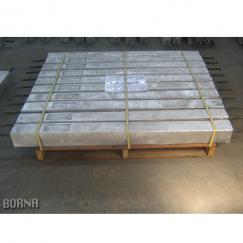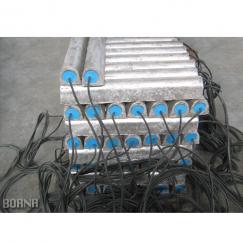Aluminum Anodes
The main use of aluminum anodes is for cathodic protection in seawater. However, these anodes can also be used in rare cases in fresh water or soil. Aluminum anodes are mainly used for cathodic protection of jetties piles, jackets, internal protection of storage tanks, external protection of submarine pipelines, etc.
To prevent the formation of an aluminum oxide layer on the anode surface, which greatly reduces the anode’s efficiency, an active element such as mercury or indium is commonly used in the chemical composition of aluminum anodes. In the past, mercury was used in the chemical composition of aluminum anodes. Although the amount of mercury in the alloy was low, with the use of the anode main body, this amount of mercury remained in the material and its concentration increased, which caused many environmental problems. Today the use of mercury in aluminum anodes is almost obsolete and the indium element is used as an activator.
View of an offshore jacket with aluminum anodes manufactured by Borna Electronics Co.
View of the casting furnace of the aluminum anodes of Borna Electronics Co.
Common standards for aluminum anodes include DIN VG 81257, DNV-RP-B401, IPS-M-TP-750, ISO 15589-2, INSO 12994-2, NACE SP0387, NORSOK M-503 and MIL-DTL-24779B. According to NACE SP0387 standard, the insert used in aluminum anodes shall be of common steel.
Borna Electronics Co. declares its readiness to design and manufacture all types of aluminum anodes based on the requests of respected clients or project needs.




